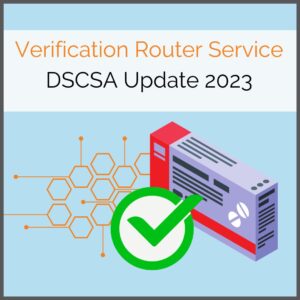
November 2023 marks an important date for the US pharmaceutical industry. The final phase of the DSCSA requirements revolves around interoperability and increased supply chain assurance. Verification Router Services (VRS) are one building block to meet the requirements.
The DSCSA requires that all trading partners have a secure, electronic, and interoperable system in place for checking and verifying prescription medicines by 27 November 2023. The tracking requirements apply to the packaging level. This deadline also concludes the final phase of DSCSA compliance. The DSCSA provisions expand to include saleable returns and suspicious product investigations.
What are the DSCSA Requirements for Wholesalers and Drug Manufacturers?
With the end of the final phase, wholesalers in the USA must verify saleable returns before reselling them. Manufacturers, in turn, are required to respond to verification requests within 24 hours, regardless of which company within the supply chain they come from.
Pharmaceutical manufacturers in the US have been required to respond to any verification request for their products since 2017. However, with the November 2023 deadline, they are supposed to have a secure electronic and interoperable system and processes in place to respond to the requests. This is to be made possible by a Verification Router Service (VRS) provided by a third party.
In the US, approximately 60 million packages are returned to wholesalers as saleable returns per year. That is 2-3 % of the total sales of US drug manufacturers. If the requirements of the DSCSA are not met, this can lead to delays in sales, unsaleability of the drugs, or even penalties by the FDA.
What is the Verification Router Service?
The VRS solution is a vendor-independent ecosystem that ensures interoperability between all parties. It makes it possible, along the different systems of wholesalers and manufacturers, to transmit a verification request in the correct format and to forward the corresponding response in the same way. There are VRS systems from different suppliers for this purpose, but they all have to be able to communicate with each other. Therefore, standards have been established jointly by the industry in recent years. Among others, GS1 and the Healthcare Distribution Alliance (HAD) are involved in these processes.
How Did the Verification Router Service Come About?
The Healthcare Distribution Alliance (HDA) conducted a pilot study (7 MAHs, 6 wholesalers) with various pharmaceutical companies in the US back in 2019 to see which method was best suited to meet the DSCSA’s requirements for verifying saleable drug returns. They investigated the impact of the different solutions on processes, costs, labour, and technology. The goal was to provide the FDA with reliable data on real-world conditions at pharmaceutical manufacturers and wholesalers while figuring out how to implement the requirements in a way that minimizes the burden on the supply chain.
As a result of the working groups, two options were recommended:
Option one provided for the manufacturer to send to each individual wholesaler the aggregated product identifiers of the product units sold to them. With this information, the wholesaler creates his internal database. He can use this to check the saleable returns and reconcile the data.
The second option was to create a Verification Router Service (VRS). In this scenario, pharmaceutical manufacturers store all their product data in a local database that is connected to the third-party VRS service. Wholesalers then send a request to the VRS provider, who in turn forwards the request to the manufacturer’s internal database. Corresponding response follows the same path back to the wholesaler.
Requirements for the VRS Ecosystem
The third-party VRS solution, considering the audit requirements of the DSCSA, must be able to forward queries from all wholesalers to the manufacturer databases (Lookup Directory, LD) in the appropriate format and report the responses from the respective systems back to the wholesalers. It poses a challenge for the VRS providers, as they must ensure synchronous 2-way communication. In addition, the VRS systems must also be able to communicate with each other to process all verification requests quickly and follow the guidelines. Although the DSCSA provides for a 24-hour feedback frame, wholesalers seem to rather expect a prompt response here without a longer processing time.
Due to the large number of medicines involved and the resulting high volume of inquiries, the VRS system was considered the better option and was pursued by the industry. The VRS is not only used for saleable returns. It also comes into play as the second important building block of the DSCSA in November 2023. Verification requests, which concern the investigation of suspicious products, can also be managed via the VRS. This part then no longer concerns only the wholesalers, but all participants in the supply chain.
The Advantages of a Verification Router Service
There are several benefits to using a VRS system to verify saleable drug returns by wholesalers.
A VRS supports
– tracking medicines along the supply chain
– inquiring about and verifying the status of products
– checking for excessive or unlawful sales of medicines.
So, a VRS is not only there to verify saleable returns, but it also covers other scenarios. These include product recalls or investigations into suspicious medicines. Not only wholesalers but also dispensers need to be able to verify medicines. So, companies that have no trading relationship at all may have to get in touch with each other. This is where Authorised Trading Partner (ATP) licenses come into play. They ensure that all actors in the supply chain can communicate with each other in a secure and authorized manner. Therefore, the VRS is also intended to enable verification here.
Accordingly, a VRS covers all requirements of the DSCSA deadline in November 2023:
– Interoperable exchange of transaction information, including product identifier.
– Verification via a secure and electronic pathway that is interoperable
– Interoperable tracking through appropriate processes and systems